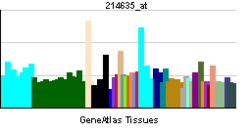CLDN9
| CLDN9 | |||||||||||||||||
|---|---|---|---|---|---|---|---|---|---|---|---|---|---|---|---|---|---|
| Identifiers | |||||||||||||||||
| Aliases | CLDN9 | ||||||||||||||||
| External IDs | MGI: 1913100 HomoloGene: 10656 GeneCards: CLDN9 | ||||||||||||||||
| |||||||||||||||||
| RNA expression pattern | |||||||||||||||||
 | |||||||||||||||||
| More reference expression data | |||||||||||||||||
| Orthologs | |||||||||||||||||
| Species | Human | Mouse | |||||||||||||||
| Entrez | |||||||||||||||||
| Ensembl | |||||||||||||||||
| UniProt | |||||||||||||||||
| RefSeq (mRNA) | |||||||||||||||||
| RefSeq (protein) | |||||||||||||||||
| Location (UCSC) | Chr 16: 3.01 – 3.01 Mb | Chr 17: 23.68 – 23.68 Mb | |||||||||||||||
| PubMed search | [1] | [2] | |||||||||||||||
| Wikidata | |||||||||||||||||
| View/Edit Human | View/Edit Mouse |
Claudin-9 is a protein that in humans is encoded by the CLDN9 gene.[3][4][5] It belongs to the group of claudins.
This gene is involved in hearing.[6]
References
- ↑ "Human PubMed Reference:".
- ↑ "Mouse PubMed Reference:".
- ↑ Peacock RE, Keen TJ, Inglehearn CF (Mar 1998). "Analysis of a human gene homologous to rat ventral prostate.1 protein". Genomics. 46 (3): 443–9. doi:10.1006/geno.1997.5033. PMID 9441748.
- ↑ Meertens L, Bertaux C, Cukierman L, Cormier E, Lavillette D, Cosset FL, Dragic T (Mar 2008). "The tight junction proteins claudin-1, -6, and -9 are entry cofactors for hepatitis C virus". J Virol. 82 (7): 3555–60. doi:10.1128/JVI.01977-07. PMC 2268462
 . PMID 18234789.
. PMID 18234789. - ↑ "Entrez Gene: CLDN9 claudin 9".
- ↑ Gene discovery reveals a critical protein's function in hearing
Further reading
- Kniesel U, Wolburg H (2000). "Tight junctions of the blood–brain barrier.". Cell. Mol. Neurobiol. 20 (1): 57–76. doi:10.1023/A:1006995910836. PMID 10690502.
- Heiskala M, Peterson PA, Yang Y (2001). "The roles of claudin superfamily proteins in paracellular transport.". Traffic. 2 (2): 93–8. doi:10.1034/j.1600-0854.2001.020203.x. PMID 11247307.
- Tsukita S, Furuse M, Itoh M (2001). "Multifunctional strands in tight junctions.". Nat. Rev. Mol. Cell Biol. 2 (4): 285–93. doi:10.1038/35067088. PMID 11283726.
- Tsukita S, Furuse M (2003). "Claudin-based barrier in simple and stratified cellular sheets.". Curr. Opin. Cell Biol. 14 (5): 531–6. doi:10.1016/S0955-0674(02)00362-9. PMID 12231346.
- González-Mariscal L, Betanzos A, Nava P, Jaramillo BE (2003). "Tight junction proteins.". Prog. Biophys. Mol. Biol. 81 (1): 1–44. doi:10.1016/S0079-6107(02)00037-8. PMID 12475568.
- Yi X, Wang Y, Yu FS (2000). "Corneal epithelial tight junctions and their response to lipopolysaccharide challenge.". Invest. Ophthalmol. Vis. Sci. 41 (13): 4093–100. PMID 11095601.
- Kiuchi-Saishin Y, Gotoh S, Furuse M, et al. (2002). "Differential expression patterns of claudins, tight junction membrane proteins, in mouse nephron segments.". J. Am. Soc. Nephrol. 13 (4): 875–86. PMID 11912246.
- Strausberg RL, Feingold EA, Grouse LH, et al. (2003). "Generation and initial analysis of more than 15,000 full-length human and mouse cDNA sequences.". Proc. Natl. Acad. Sci. U.S.A. 99 (26): 16899–903. doi:10.1073/pnas.242603899. PMC 139241
 . PMID 12477932.
. PMID 12477932. - Katoh M, Katoh M (2004). "CLDN23 gene, frequently down-regulated in intestinal-type gastric cancer, is a novel member of CLAUDIN gene family.". Int. J. Mol. Med. 11 (6): 683–9. doi:10.3892/ijmm.11.6.683. PMID 12736707.
- Ban Y, Dota A, Cooper LJ, et al. (2003). "Tight junction-related protein expression and distribution in human corneal epithelium.". Exp. Eye Res. 76 (6): 663–9. doi:10.1016/S0014-4835(03)00054-X. PMID 12742348.
- Kitajiri SI, Furuse M, Morita K, et al. (2004). "Expression patterns of claudins, tight junction adhesion molecules, in the inner ear.". Hear. Res. 187 (1-2): 25–34. doi:10.1016/S0378-5955(03)00338-1. PMID 14698084.
- Ota T, Suzuki Y, Nishikawa T, et al. (2004). "Complete sequencing and characterization of 21,243 full-length human cDNAs.". Nat. Genet. 36 (1): 40–5. doi:10.1038/ng1285. PMID 14702039.
- Gerhard DS, Wagner L, Feingold EA, et al. (2004). "The status, quality, and expansion of the NIH full-length cDNA project: the Mammalian Gene Collection (MGC).". Genome Res. 14 (10B): 2121–7. doi:10.1101/gr.2596504. PMC 528928
 . PMID 15489334.
. PMID 15489334. - Zheng A, Yuan F, Li Y, et al. (2007). "Claudin-6 and claudin-9 function as additional coreceptors for hepatitis C virus.". J. Virol. 81 (22): 12465–71. doi:10.1128/JVI.01457-07. PMC 2169001
 . PMID 17804490.
. PMID 17804490. - Liu F, Koval M, Ranganathan S, Fanayan S, Hancock WS, Lundberg EK, Beavis RC, Lane L, Duek P, McQuade L, Kelleher NL, Baker MS (2015). "A systems proteomics view of the endogenous human claudin protein family". J Proteome Res. doi:10.1021/acs.jproteome.5b00769. PMID 26680015.
This article is issued from Wikipedia - version of the 6/6/2016. The text is available under the Creative Commons Attribution/Share Alike but additional terms may apply for the media files.